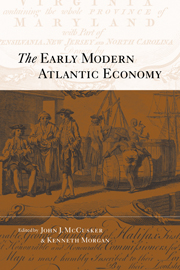Book contents
- Frontmatter
- Contents
- List of figures
- List of tables
- List of abbreviations
- List of contributors
- Dedication
- Introduction
- Part I The role of merchants and their connections
- Part II The development of trades
- Part III Imperial economies
- Part IV Colonial working societies
- 12 Emigration and the standard of living: the eighteenth-century Chesapeake
- 13 After tobacco: The slave labour pattern on a large Chesapeake grain-and-livestock plantation in the early nineteenth century
- Index
13 - After tobacco: The slave labour pattern on a large Chesapeake grain-and-livestock plantation in the early nineteenth century
from Part IV - Colonial working societies
Published online by Cambridge University Press: 16 October 2009
- Frontmatter
- Contents
- List of figures
- List of tables
- List of abbreviations
- List of contributors
- Dedication
- Introduction
- Part I The role of merchants and their connections
- Part II The development of trades
- Part III Imperial economies
- Part IV Colonial working societies
- 12 Emigration and the standard of living: the eighteenth-century Chesapeake
- 13 After tobacco: The slave labour pattern on a large Chesapeake grain-and-livestock plantation in the early nineteenth century
- Index
Summary
The early modern Atlantic economic system depicted by the previous essayists in this volume – in which labourers from Africa cultivated sugar, rice and tobacco crops in America that were marketed in Europe – developed in unexpected and unusual ways in one important region of the Atlantic world. In Virginia and Maryland, market forces created a plantation system at the close of the eighteenth century with a surplus of agricultural labourers. Elsewhere in America, labour shortages were endemic, especially in the sugar plantations on the Caribbean islands where the work gangs could only be sustained through massive and continuous importation of new labourers. Why a surplus developed in the Chesapeake by 1800 is well understood, but the management practices of the leading planters with the largest number of labourers during the first two decades of the nineteenth century have been little examined. This chapter endeavours to throw some fresh light on the post-revolutionary Chesapeake agricultural labour pattern. From the 1620s to the 1770s, tobacco had of course been the Virginia and Maryland mainstay. As Jacob Price has demonstrated in his masterly series of books and articles on the transatlantic tobacco trade, this staple crop was marketed skilfully and profitably by English and Scottish entrepreneurs, with much of the Chesapeake production re-exported from Britain to France and other European venues. From the beginning, the colonial tobacco planters required a large and dependable supply of unskilled manual workers for their labour-intensive crop.
- Type
- Chapter
- Information
- The Early Modern Atlantic Economy , pp. 344 - 363Publisher: Cambridge University PressPrint publication year: 2001

